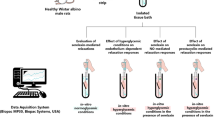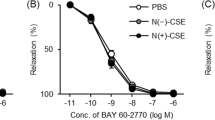Abstract
Nitric oxide (NO) activates corpus cavernosum smooth muscle soluble guanylate cyclase (sGC) and increases the synthesis of cGMP that results in smooth muscle relaxation and ultimately, penile erection. To characterize sGC and define the potential synergy between NO and the allosteric activator YC-1 in corpus cavernosum, rat sGC was activated by either sodium nitroprusside (SNP) or YC-1, and YC-1 potentiated the effects of SNP with a 200-fold activation of sGC. Both SNP and YC-1 decreased the Km and increased the Vmax. ODQ significantly inhibited sGC activated by SNP with IC50 of 0.5 nM, but did not affect the sGC activated by YC-1 as well as basal sGC activity. SNP and YC-1 synergistically increased intracellular cGMP levels in rabbit corpus cavernosum smooth muscle cell cultures. YC-1 significantly relaxed rabbit cavernosum tissue strips in organ baths with an EC50 of 8.4 μM. In the presence of L-nitroarginine methyl ester to block endogenous NO production, co-administration of SNP shifted the dose response of YC-1 to the left, showing the synergism of SNP and YC-1 in tissue strips. In view of the clinical efficacy of phosphodiesterase-5 inhibitors, activation of sGC may provide an alternative means for enhancing the activity of neurally derived NO during sexual stimulation in the corpus cavernosum, representing a novel approach for the treatment of erectile dysfunction.
This is a preview of subscription content, access via your institution
Access options
Subscribe to this journal
Receive 8 print issues and online access
$259.00 per year
only $32.38 per issue
Buy this article
- Purchase on Springer Link
- Instant access to full article PDF
Prices may be subject to local taxes which are calculated during checkout






Similar content being viewed by others
References
Behrends S, Steenpass A, Porst H, Scholz H. . Expression of nitric oxide-sensitive guanylyl cyclase subunits in human corpus cavernosum. Biochem Pharmacol 2000 59: 713–717.
Klotz T et al . Soluble guanylate cyclase and cGMP-dependent protein kinase I expression in the human corpus cavernosum. Int J Impot Res 2000 12: 157–164.
Wu CC, Ko FN, Kuo SC, Lee FY, Teng CM. . YC-1 inhibited human platelet aggregation through NO-independent activation of soluble guanylate cyclase. Br J Pharmacol 1995 116: 1973–1978.
Stone JR, Marletta MA. . Synergistic activation of soluble guanylate cyclase by YC-1 and carbon monoxide: implications for the role of cleavage of the iron-histidine bond during activation by nitric oxide. Chem Biol 1998 5: 255–261.
Friebe A, Koesling D. . Mechanism of YC-1-induced activation of soluble guanylyl cyclase. Mol Pharmacol 1998 53: 123–127.
Nakane M, Saheki S, Kuno T, Ishii K, Murad F. . Molecular cloning of a cDNA coding for 70 kilodalton subunit of soluble guanylate cyclase from rat lung. Biochem Biophys Res Commun 1988 157: 1139–1147.
Nakane M, Arai K, Saheki S, Kuno T, Buechler W, Murad F. . Molecular cloning and expression of cDNAs coding for soluble guanylate cyclase from rat lung. J Biol Chem 1990 265: 16841–16845.
O'Reilly DR. . Use of baculovirus expression vectors. Methods Mol Biol 1997 62: 235–246.
Hoenicka M et al . Purified soluble guanylyl cyclase expressed in a baculovirus/Sf9 system: stimulation by YC-1, nitric oxide, and carbon monoxide. J Mol Med 1999 77: 14–23.
Gupta S et al . The expression of functional postsynaptic alpha2-adrenoceptors in the corpus cavernosum smooth muscle. Br J Pharmacol 1998 123: 1237–1245.
Hussain AS, Marks GS, Brien JF, Nakatsu K. . The soluble guanylyl cyclase inhibitor 1H-[1,2,4] oxadiazolo [4,3-alpha] quinoxalin-1-one (ODQ) inhibits relaxation of rabbit aortic rings induced by carbon monoxide, nitric oxide, and glyceryl trinitrate. Can J Physiol Pharmacol 1997 75: 1034–1037.
Zhao Y et al . Inhibition of soluble guanylate cyclase by ODQ. Biochemistry 2000 39: 10848–10854.
Wegener JW, Closs EI, Forstermann U, Nawrath H. . Failure of 1H-[1,2,4] oxadiazolo [4,3-a] quinoxalin-1-one (ODQ) to inhibit soluble guanylyl cyclase in rat ventricular cardiomyocytes. Br J Pharmacol 1999 127: 693–700.
Ko FN et al . YC-1, a novel activator of platelet guanylate cyclase. Blood 1994 84: 4226–4233.
Teng CM et al . YC-1, a nitric oxide-independent activator of soluble guanylate cyclase, inhibits platelet-rich thrombosis in mice. Eur J Pharmacol 1997 320: 161–166.
Brandish PE, Buechler W, Marletta MA. . Regeneration of the ferrous heme of soluble guanylate cyclase from the nitric oxide complex: acceleration by thiols and oxyhemoglobin. Biochemistry 1998 37: 16898–16907.
Stasch JP et al . NO-independent regulatory site on soluble guanylate cyclase. Nature 2001 410: 212–215.
Friebe A, Russwurm M, Mergia E, Koesling D. . A point-mutated guanylyl cyclase with features of the YC-1-stimulated enzyme: implications for the YC-1 binding site? Biochemistry 1999 38: 15253–15257.
Denninger JW et al . Interaction of soluble guanylate cyclase with YC-1: kinetic and resonance Raman studies. Biochemistry 2000 39: 4191–4198.
Mulsch A et al . Effect of YC-1, an NO-independent, superoxide-sensitive stimulator of soluble guanylyl cyclase, on smooth muscle responsiveness to nitrovasodilators. Br J Pharmacol 1997 120: 681–689.
Wegener JW, Gath I, Forstermann U, Nawrath H. . Activation of soluble guanylyl cyclase by YC-1 in aortic smooth muscle but not in ventricular myocardium from rat. Br J Pharmacol 1997 122: 1523–1529.
Wohlfart P et al . Release of nitric oxide from endothelial cells stimulated by YC-1, an activator of soluble guanylyl cyclase. Br J Pharmacol 1999 128: 1316–1322.
Acknowledgements
We thank Annemarie Rueter and Robert Simmer for helping the expression of sGC in Baculovirus system.
Author information
Authors and Affiliations
Corresponding author
Rights and permissions
About this article
Cite this article
Nakane, M., Hsieh, G., Miller, L. et al. Activation of soluble guanylate cyclase causes relaxation of corpus cavernosum tissue: synergism of nitric oxide and YC-1. Int J Impot Res 14, 121–127 (2002). https://doi.org/10.1038/sj.ijir.3900843
Received:
Revised:
Accepted:
Published:
Issue Date:
DOI: https://doi.org/10.1038/sj.ijir.3900843
Keywords
This article is cited by
-
Homogeneous single-label cGMP detection platform for the functional study of nitric oxide-sensitive (soluble) guanylyl cyclases and cGMP-specific phosphodiesterases
Scientific Reports (2020)
-
In vitro and in vivo studies on the importance of the soluble guanylyl cyclase α1 subunit in penile erection
World Journal of Urology (2010)
-
Role of the soluble guanylyl cyclase α1-subunit in mice corpus cavernosum smooth muscle relaxation
International Journal of Impotence Research (2008)
-
NO-independent stimulators and activators of soluble guanylate cyclase: discovery and therapeutic potential
Nature Reviews Drug Discovery (2006)
-
In vitro models: research in physiology and pharmacology of the lower urinary tract
British Journal of Pharmacology (2006)



